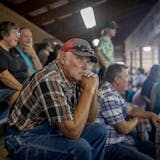The Oct. 29 column "A Park Board possibly in flux" claimed that I want to end the use of pesticides in parks but that I don't have a plan for such a transition. This is a little like saying that Bob Dylan likes music but hasn't written any songs.
This claim was made without calling me, writing to me or reaching out in any way. My website shows that I've written and spoken extensively about my plan to transition away from pesticides. This summer I gave eight speeches on the topic, one of which is captured on my website in video. Since all of my outreach — as well as my 13-year history as the owner of an organic landscaping company — seems to have been ignored, I'll state once again for the record my plan to eliminate pesticides in parks:
By the Minneapolis Park and Recreation Board definition, pesticides include herbicides, insecticides, fungicides and any other chemical used to kill living creatures in the landscape. My first step will be to ask other board members to vote with me to establish a pesticide-elimination committee. This committee will be charged with developing and implementing a four- to five-year transition plan and will be directed to work with a similar committee established earlier in the year by the Minneapolis Public Schools. It will need to include boots-on-the-ground staff as well as top-level staff responsible for departments that use pesticides in our park system. It also will include park users and activists who are seeking an end to pesticide use in the city.
Once our committee is up and running, we will request data from both the parks and the school system on the uses of pesticides; it is important for everyone to be on the same page about the extent of use currently. With the data in hand, I will likely move for a blanket ban on two pesticides that our park system uses in abundance, Roundup and 2,4-D. (Last week, the European Parliament voted to support a ban on what is perhaps the most controversial pesticide in the world, glysophate, the main ingredient in Roundup, because of concerns that it causes cancer. Meanwhile, 2,4-D is controversial because it is spread in pellet form and birds mistake these pellets for seeds.) After we see what pesticides are being used by our parks and schools, there may be additional blanket bans to be considered.
The next step will be to work with departments to define the problems that we use pesticides to deal with. As we get a sense of the scope and scale of the landscape-management issues faced by our park system, we'll better understand the areas of greatest need for a transition plan. Determining the scope of pesticide use will also help us determine the appropriate educational resources required to facilitate a transition.
We'll then seek advice and consultation from soil-health and pesticide-elimination experts. Within six months after our team has begun meeting, I will work toward a policy and funding plan for soil-health and pesticide-elimination training for all staff who now work with pesticides. As strategies are implemented, I will work with the Park Board to support and uplift employees who, with their new training, will become our leaders in pesticide-free landscape management. Throughout the transition, I'd like us to educate community members on our efforts and strategies so that they can join in eliminating pesticides from our city environment.
Recognizing that we need commissioners who themselves have a background in pesticide elimination and soil health in order to facilitate a full transition, I've worked for the past three years to become educated in science-based strategies for pesticide-free management. I've learned how to assess and manage soil microbial communities that support plant health and reduce weed and pest pressure.
Over the past few months, I've taken my training into the real world by performing an experiment on my boulevard at home. Lawns are the biggest user of pesticides in our park system. Golf course and premier ball field lawns are regularly treated with herbicides such as 2,4-D and Roundup, so they are likely to represent the largest uses of pesticides in our park system. I chose the boulevard because it's one of the most difficult spaces to grow healthy, weed-free lawns.


